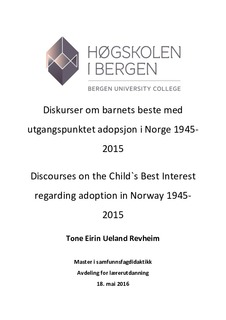| dc.contributor.author | Revheim, Tone Eirin Ueland | |
| dc.date.accessioned | 2018-02-01T15:08:47Z | |
| dc.date.available | 2018-02-01T15:08:47Z | |
| dc.date.issued | 2016-05-18 | |
| dc.identifier.uri | http://hdl.handle.net/11250/2481812 | |
| dc.description | Master i samfunnsfagdidaktikk | en_GB |
| dc.description.abstract | Denne masteroppgaven er en kvalitativ studie om innholdet i prinsippet om barnets beste med utgangspunktet nasjonal adopsjon i norsk etterkrigstid. Barnets beste er nedfelt i de ulike lovene som omhandler nasjonal adopsjon og det er tidligere skrevet flere oppgaver som tar utgangspunkt i lovverket tilknyttet adopsjon, men ikke hva som driver frem disse lovene. Det er ikke skrevet mye om hvorvidt disse lovene er et svar på nye holdninger i samfunnet tilknyttet innholdet i barnets beste. Problemstillingen som belyses i denne oppgaven er derfor: Hvordan har hensynet til barnets beste blitt fortolket i forhold til enslige mødres valg og nasjonal adopsjon i årene 1945-2015? Problemstillingen besvares ved hjelp av underkategorier av dokumentanalyse; kvalitativ innholdsanalyse og diskursanalyse. Diskursteori har bidratt til å gi meg verktøyene til analysere materialet og dele det inn i ulike diskurser for å få tak i fortolkningen av prinsippet om barnets beste. Ved hjelp av disse metodene ble materialet, som utgjør avisartikler fra 1945-2015, utvalgt, kategorisert og analysert. Resultatet av studien viser at holdninger og meninger, om innholdet i barnets beste, som utgjør de offentlige dokumentene, lover og lovforarbeidene er tilstede i deler av befolkningen før de når myndighetene. Representantene kan med det være en pådriver for nye lover og lovendringer som omhandler nasjonal adopsjon. Særlig gjelder dette i et skifte fra en tanke om at barnets beste var det samme som foreldrenes beste til å prioritere barnet og dets beste først. Adopsjonsloven av 1986 følger denne holdningsendringen ved å tydeliggjøre barnets beste i ordlyden. Det er særlig to motpoler som går igjen som holdninger i materialet til hva som er innholdet i barnets beste. Dette gjelder det biologiske prinsipp, der barnets beste er å være hos sine biologiske foreldre, og et syn der adopsjon er det beste for barnet. Likevel er materialet mer nyansert og det er alltid noen som har meninger i en mellomposisjon mellom disse to motpolene i hva som regnes som barnets beste. Resultatet ble derfor at barnets beste regnes som å ha en viss kontakt med sine biologiske foreldre, uavhengig om det er adoptert bort eller ikke. Detter er også tydelig ved innføringen av åpen adopsjon av fosterbarn i 2010. | en_GB |
| dc.description.abstract | This master thesis is a qualitative study of the content on the ”the Best Interest of the Child” regarding adoption from 1945-2015 in Norwegian context. This principle is enshrined in the laws regarding national adoption. Former researches have focused on laws concerning adoption, but not what motivates these laws and the changes made to them, and if they are a result of new opinions in society regarding the content on“the Childs best interest.” The focus question for this master thesis is therefore: How has the consideration on the Child`s best interest been interpreted regarding single mothers’ choice and national adoption during the years of 1945-2015? The methods used to answer this research question are under categories of document analysis; qualitative content analysis and discourse analysis. Discourse theory has given me the tools to analyze my material and divide it into different discourses to grasp the interpretations of the principle on the child’s best interest. By using these methods was I able to choose, categorize and analyze my material, which was newspaper articles from 1945-2015. The result of this study have shown that the opinions and beliefs, which are present in the laws, also are present in the population before they reach the government. This shows that the representatives could have an effect on the government regarding new laws on adoption. This is especially seen in the change from focusing on the mother’s best interest, instead of the child’s best interest and seeing these two as the same, to focusing on the best interest on the child. The best interest of the child is having some contact with its biological family, independently from whether it is adopted or not. The law on adoption from 1986 shows this shift by clarifying the principle on “the Childs best interest”. There are especially two opposite opinions throughout the material for this master thesis of what is the content of the principle of the best interest of the child. These are the biological principle, where the best interest for the child is being with its biological parents, and believing that adoption is in the child’s best interest. However, there is clearly a middle position of opinions as well, where the child’s best interest was then to have some contact with their biological parents, independent of whether the child was adopted or not. This opinion is clear also from the government position with the passing of the law that allows open adoptions of foster children from 2010. | en_GB |
| dc.language.iso | nob | en_GB |
| dc.publisher | Bergen University College | en_GB |
| dc.rights | Attribution-NonCommercial-NoDerivs 3.0 Norway | * |
| dc.rights.uri | http://creativecommons.org/licenses/by-nc-nd/3.0/no/ | * |
| dc.subject.other | Samfunnsfagdidaktikk | en_GB |
| dc.title | Diskurser om barnets beste med utgangspunktet adopsjon i Norge 1945- 2015 | en_GB |
| dc.title.alternative | Discourses on the Child`s Best Interest regarding adoption in Norway 1945- 2015 | en_GB |
| dc.type | Master thesis | en_GB |
| dc.subject.nsi | Samfunnsfagdidaktikk | en_GB |

